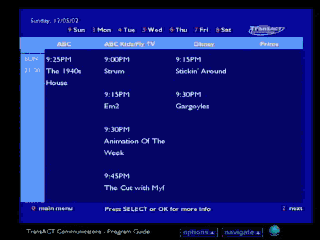My Smart Apartment
These are some notes for a five minute talk at panel session on Home Technology Convergence. Other panelists were vendors and I was there to provide a skeptical view as an IT professional and user of home automation. Home automation as to be: affordable, reliable, maintainable and useful. With some effort Home Technology Convergence can happen and survive natural disaster and terrorist attack.
Idea from Joint Operations Centre, USS Blue Ridge

In many ways my apartment is similar to the deployable military headquarters I looked at while at the Defence Department. With this arrangement a bare room is supplied with power and telecommunications. The personnel arrive with their laptop computers and plug them in.
My Smart Apartment
In 2001 I purchased an apartment in the new "City Edge" development in O'Connor, an inner north Canberra suburb. The building was equipped with a broadband fibre optic cable to the basement, serviced by Transact (a Canberra based broadband service provider). So I decided to set up the apartment as a usable but hi-technology showcase "Smart Apartment.

Transact Optical Cable into Basement

Patch Panel in Apartment

Cables to Set-Top-Box

Web STB TV Guide

Plans

Apartments designed for the disabled

See: "The Smart Apartment- The Digital Home of Today", May 2003
Rather than an expensive and inflexible built in home office I decided to have a portable one. This simply consists of my laptop computer on the dining table and plugged into the set top box. Later I added a WiFi wireless connection.
Much home automation may be rendered obsolete by advanced mobile telephone services. This year I have been teaching ANU IT students how to design web pages for mobile telephones and for disabled users. It is now possible to design a web page which detects what sort of device it is being displayed on and adjusts it format and content to suit. To demonstrate is a web page which displayed normally on a desktop computer. When printed, the interactive menus of the web page are omitted (as they are no use on a non-interactive document), on a hand-held device the margins are reduced and the text put in one column to suit the small screen. For projection most of the text disappears, the margins made larger and a background image added to give a slide show. This can be machine translated into Chinese.
Fires Around Canberra 18 January 2003

Map of Fires Around Canberra 18 January 2003, Sentinel, CSIRO, 2003, URL: http://www.sentinel.csiro.au
See: Dealing with Disaster - Using new Networking Technology for Emergency Coordination, November 2003, URL: http://www.tomw.net.au/2003/enet.html
Because while the rest of the complex was being constructed the builders would occasionally cut off the power to my apartment I purchased a $300 UPS to run the set top box. This turned out useful in the bush fires. At one stage the emergency descended into a dangerous farce. ABC Radio reported that mains power had been lost to the emergency centre. Fires had effected the power lines across Canberra, causing blackouts and brownouts. The centre's backup generator failed to start. While this was happening and throughout the emergency, my home office was unaffected. During short blackouts and brownouts the UPS automatically took over supplying power to the set top box, providing continuous broadband access from a fibre optic cable in the basement. My laptop computer continued to run from battery. Internet and web services were unaffected by the fires, as the telephone (also supplied via Transact).
See also:
-
Dealing with Disaster: Using new Networking Technology for Emergency, First presented at the Industry Outlook Conference 2003, Canberra November 2003
